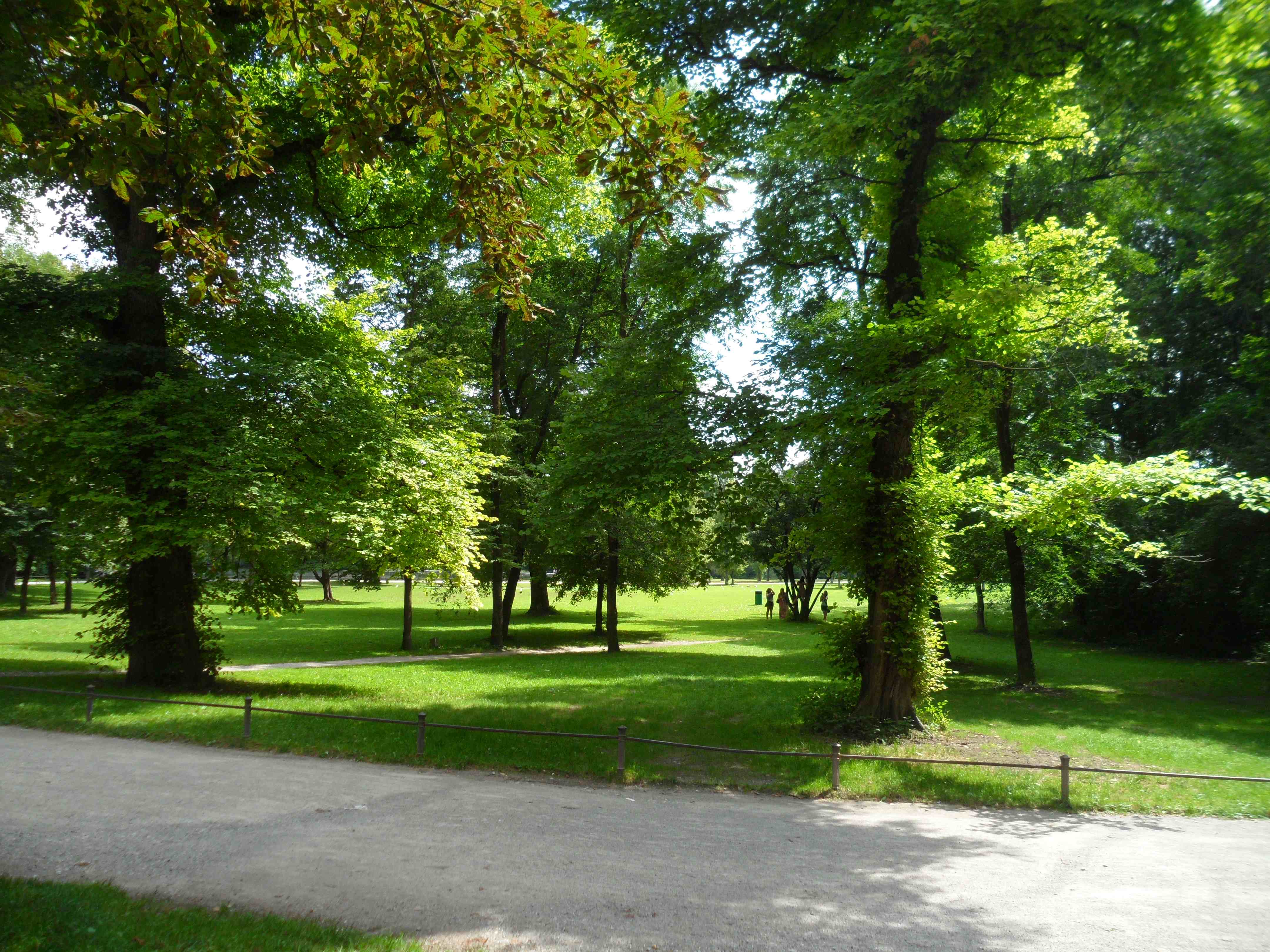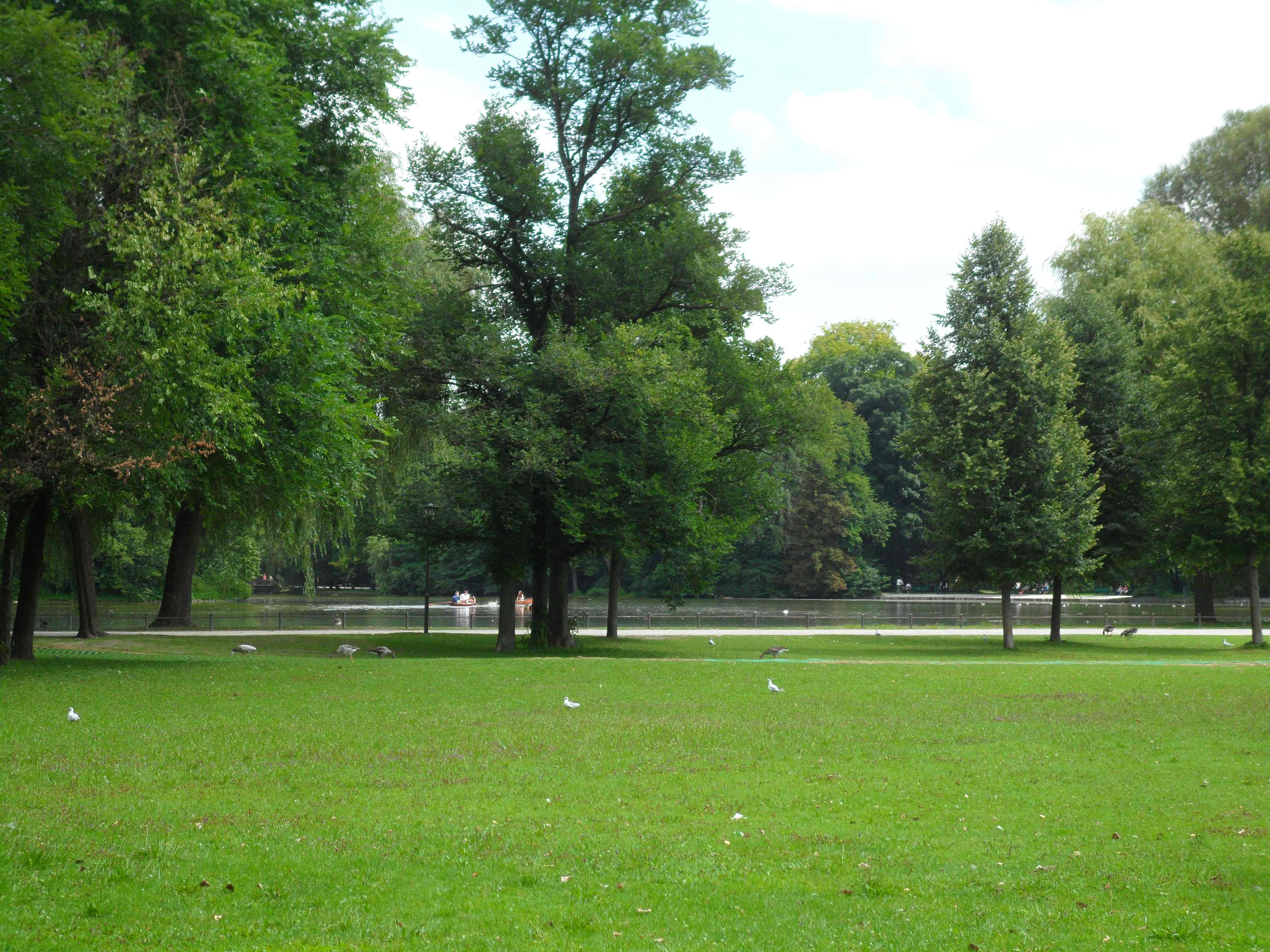Dayhiking in Socialist Munich

Name of hike: Dayhiking in green Munich’s large urban parks
Mileage: As much as you can take
Suggested time: Late spring or mid-fall is ideal, weather-wise.
While visiting the city of Munich I’ve been struck by the coincidence of the Socialist-Democratic Party’s [SPD’s] long dominance there and the celebrated “green” character of this historic town. Since World War II, the SPD has long-dominated the city’s government, even while the conservative Christian Social Union has generally controlled the rest of Bavaria.
Enlightened social democrat policies have enhanced the attractiveness of the famously “green” city, and not only to Germans. In various rankings of “most livable cities” in the world, Munich (Muenchen) has usually been ranked in the top ten over the last few years. For example, the lifestyle magazine Monocle ranked the Bavarian capital of 1.4 million number one in 2010, and number five in 2012. Some of the magazine’s criteria concerning “quality of life” include safety, public transportation, tolerance, business conditions, urban design, environmental issues, and access to nature. Contrary to many Americans’ unfounded assumptions, socialist Munich has a vibrant business community, making it a commercial leader in publishing, electronics (Siemens), manufacturing (BMW), and financial services. (Disclosure: I lived in Munich at one point in the 1970s.)

In my last column, White Ledge solo backpack, there was a list of British economist Robert Skidelsky’s seven human “Goods” required for the good life, and harmony with nature was one of these. This criterion of course requires the access to nature for which Munich has become deservedly famous. (Those of us lucky enough to live in Santa Barbara also enjoy tremendous access to nature.) There isn’t space here to recount all the famous artists, writers, and scientists who have lived in this fabulous city, Germany’s third largest, but they include Kandinsky, Franz Marc (Blue Rider School), Michael Haneke, Thomas and Heinrich Mann, Werner von Heisenberg, Max Planck, Albert Einstein, and many others. The current Pope Benedict XVI attended high school in Munich, and was the unpopular archbishop of the city for several years. Thomas Mann includes some key descriptions of this “carnival city” in his great novel Dr. Faustus. It’s only fair to acknowledge that Munich was also Hitler’s favorite city and he saw it as the center of his vicious NSDAP movement in the 1930s. During World War II, Munich paid for this by enduring over 70 massive air raids which destroyed most of the town.
Why do so many of us who have lived in and visited Munich consider it especially nature-friendly — a great place for dayhikes?

The celebrated Englischer Garten (English Garden) leads the list in a spectacular way: At 910 acres, it is one of the largest urban parks in the world, located roughly in the center of Munich. (New York’s Central Park is a mere 843 acres; San Francisco’s Golden Gate Park 410 acres, and our own Rattlesnake Canyon Wilderness comprises around 450 acres. )
You can hike for hours in the English Garden surrounded by vast green commons and tall trees, while never observing a single city building. The pure waters of the Isar River flow through this pastoral setting, and there’s even a standing wave where you can see German youth actually surfing the river. There are bike paths, a nudist area, flocks of sheep, horseback riding zones, nature trails galore. While it’s mostly flat, there are a few gentle hills. I have enjoyed many dayhikes in this park over the years, mostly recently in early August 2012.
On occasion, map in hand, I have hiked for hours and managed to get entirely outside the city and into the green countryside. For those who desire to mix refreshment with their dayhiking, you can find various Biergarten (beer gardens) to wet your whistle with soft drinks, wine, and the beer for which Munich is justly famous. The largest one is situated next to a huge Chinese pagoda. I recommend Augustiner Bier, a local brewery founded in 1328.
An American connection is that the name “English” Garden comes from the park’s American-born designer, Benjamin Thompson, who originally planned the park in 1789 for the Elector Palatinate, Carl Theodor. (A Loyalist, Thompson fled to England in the Revolutionary War, hence English Garden). The more important aspect of the term is that “English garden” is used outside the English-speaking world to refer to the informal style of landscape gardening which was popular in the United Kingdom after the 1750s. We could contrast the formal French garden style of the Luxembourg Gardens in Paris or at Versailles. Our own Alameda Park in Santa Barbara could be described as an English style garden.
Munich boasts several other large green spaces that contribute to that harmony with nature which Skidelsky and others deem absolutely essential to leading a good life.
The Olympiapark, former site of the ill-fated 1972 Olympic Games, includes many urban structures but also extensive green areas in which to wander. The German organizers of the 1972 Olympic Games specifically sought to have a green Olympics, somewhat of a new concept but certainly in the spirit of the original sports venues in ancient Olympia, Greece.
The oldest public park in Munich is the large Hofgarten, located near the English Garden and the Marienplatz (city center), and originally established about 1615. The Temple to Diana is noteworthy there, as well as the important square black granite memorial to the anti-Hitler White Rose resistance group, centered in Munich. When I take student groups to Munich we spend time at the White Rose memorial there (and at the University of Munich): Hans and Sophie Scholl and five others, including their heroic philosophy professor, made an important, if futile, resistance to the Nazis in 1943-1944 and were beheaded after a show trial for their audacity.
Another ginormous public park where you can enjoy extended urban dayhiking is the 178-acre Westpark, only completed in 1983, and including a rose garden with 20,000 roses, a lake, and the inevitable beer garden.
More gardens for dayhiking can be found at the Nymphenburg Palace, along with the nearby Munich Botanic Garden, as well as extensive areas to walk at the Schleissheim Palace. There are dozens of “pocket parks” which are also enjoyable, especially for young children, but these won’t accommodate long dayhikes.
Munich is so extraordinarily livable for many reasons, and harmony with nature is very high among them. Environmental pollution is low for such a large city, the crime rate is low compared to Hamburg or Berlin, and the city atmosphere feels quite tolerant. Only about 70% of the city is ethnic German, and the population includes over 10% non-Europeans including many Turkish Moslems and Asians.
The two universities, LMU (Ludwig Maximilians Universität) and Technisches Universität, attract over 80,000 students, many of them foreigners. Unlike UC – and SBCC – foreign students are not charged outrageous triple and quadruple fees since the Bavarian state government wisely understands that “outlanders” enhance tolerance and add vitality to their fair capital.
While visiting Munich, the intrepid tourist enjoys the ubiquitous art museums, efficient public transport (underground), multicultural restaurants, and very friendly citizens — he also avails himself every day of the enticing opportunities to wander about in the many green spaces. Jogging, dayhiking, and biking are literally right outside your hotel door. These bucolic expanses are open to all and subsidized by the socialist Munich.
Since World War II the city has had an almost unbroken series of SPD governments; currently the SPD shares power with the powerful Green Party and the Pink List (Rosa Liste) gay rights party. This is interesting since the rest of Bavaria goes with the conservative CSU party (here we would call this group center rather than right-wing). Munich’s very dynamic economy had an unemployment rate [Arbeitslosigkeit] of 4.3% in 2011, and in 2006 blue-collar workers averaged over $18 per hour. Germany itself almost outproduces China (!), and both the city and the nation thus give the lie to American conservatives’ ritual criticisms that social democracy destroys incentive.



